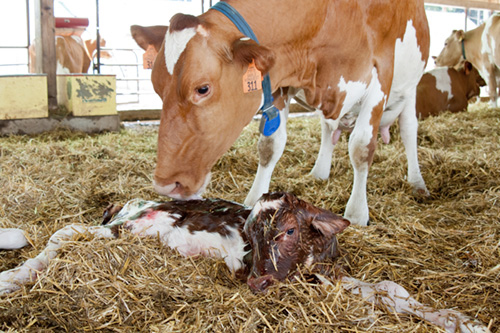
"One of the most important events on a dairy is calving," said Mark Thomas, D.V.M., a New York veterinarian and consultant with Dairy Health and Management Services, LLC.
During his presentation at the Calf and Heifer Congress in Rochester, N.Y., Thomas emphasized that the events that occur before, during and after parturition can have a significant impact on the livelihood of the cow and calf.
Any process that disrupts or prevents the normal birthing process is considered a difficult birth or dystocia. Thomas explained three basic causes of dystocia: a problem with the cow (lack of uterine contractions, hypocalcemia, small pelvic diameter or uterine torsion), a problem with the calf (malpresentation or abnormal position, excessive size, deformity, twins or decomposition of the fetus), or a combination of the two.
One major problem associated with difficult calvings is the elevated risk of stillbirths. There are many published risk factors for dystocia and stillbirths on the farm, the most common being a disproportion between the fetus and the pelvis, Thomas said. In particular, research from 2006 found the odds of stillbirth to drop 36 percent for every 1 percent decrease in calf birth weight relative to dam body weight. The same research also found a 5.2 times greater risk for stillbirths in first-calf heifers than cows.
Studies over the past few decades have pinpointed other risk factors that lead to dystocia and/or stillbirths. A few include:
-A generally observed 25 percent higher risk for dystocia with male calves, caused not only by size but by other morphological differences, as well.
-Extreme body condition (less than 2.75 or greater than 3.5) has been found to have a significant effect on stillbirth risk.
-Calcium status of the cow can play a role, with a 22 percent reduction in stillbirths found for every 1 mg/dl increase in serum calcium.
-A case of bovine respiratory disease (BRD) as a calf has been correlated with a 1.5 times greater risk of a calving ease score greater than 2 at first calving compared to untreated herdmates.
The causes are many, but on some farms, the rate of stillbirths is concerning, Thomas said. He encouraged farms to train employees in the maternity area to know the stages of calving and when to intervene. "Formal training is critical to success," he said, "and understanding normal parturition is critical to detecting the abnormal."
He highlighted the importance of follow-up observations and retraining if needed, and engaging a veterinarian in the teaching process. He also emphasized good communication between employees, working carefully and intervening only when needed.
"We are delivering babies, let's keep this in mind," he said.
 The author is an associate editor and covers animal health, dairy housing and equipment, and nutrient management. She grew up on a dairy farm near Plymouth, Wis., and previously served as a University of Wisconsin agricultural extension agent. She received a master's degree from North Carolina State University and a bachelor's from University of Wisconsin-Madison.
The author is an associate editor and covers animal health, dairy housing and equipment, and nutrient management. She grew up on a dairy farm near Plymouth, Wis., and previously served as a University of Wisconsin agricultural extension agent. She received a master's degree from North Carolina State University and a bachelor's from University of Wisconsin-Madison.







